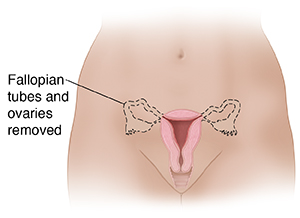Understanding Bilateral Salpingo-Oophorectomy
Understanding Bilateral Salpingo-Oophorectomy

A bilateral salpingo-oophorectomy is a type of surgery. During the surgery, a surgeon removes both ovaries and fallopian tubes from your pelvis. The ovaries are located on either side of the uterus. They make your eggs (ova). They also make the hormone estrogen. The fallopian tubes link the ovaries to the uterus. They carry the ova to the uterus.
This procedure causes you to go through menopause. You can no longer have children after it is done.
sal-PING-goh-oh-oh-fuhr-EK-tuh-mee
Why bilateral salpingo-oophorectomy is done
This procedure is done if you have cancer in the ovaries or fallopian tubes. Or you may have it to lower your risk for cancer in these parts of the body. You may be at high risk if you have a family member who had ovarian or breast cancer. You may also have a mutation in the breast cancer susceptibility (BRCA) genes. These are genes that make tumor suppressor proteins. If these genes are mutated, they do not work as they should and cells are more likely to develop cancer.
This procedure may also be done at the time you have your uterus removed. This is called a hysterectomy. Other health problems may call for taking out the ovaries and fallopian tubes at the same time and may include pelvic pain, infection, or ovarian cysts
How bilateral salpingo-oophorectomy is done
You will check into a hospital. You may need to spend a few days there after this surgery. During the procedure:
-
You are given medicine to make you fall asleep. You won’t feel any pain.
-
The surgeon may make a cut in your belly to reach the reproductive organs, or he or she may make 2 or 3 small incisions in which laparocopic instruments are inserted to reach the reproductive organs.
-
The surgeon removes your ovaries and fallopian tubes.
-
The surgeon then ties and stitches up all open wounds. The cut in the abdomen is closed up.
Risks of bilateral salpingo-oophorectomy
-
Bleeding
-
Infection
-
Injury to the bladder
-
Injury to the intestines
-
Risks linked to early menopause, such as heart disease and bone loss
Updated:
March 16, 2019
Sources:
Concepcion DA. Bilateral Salpingo-oophorectomy. In: Towsend CM, editor. Atlas of General Surgical Techniques. Philadelphia: Saunders; 2010. p. 1085-91., Muto MG. Risk-reducing bilateral salpingo-oophorectomy in women at high risk of epithelial ovarian and fallopian tubal cancer. Up To Date. September 17 ed: Up To Date; 2015. p. 32.
Reviewed By:
Howard Goodman MD,Donna Freeborn PhD CNM FNP